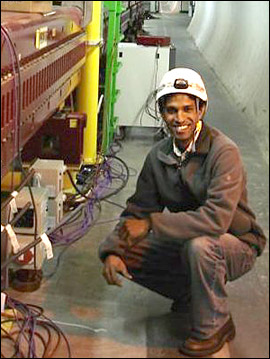Difference between revisions of "Careers ASE Rama Calaga"
YichaoJing (Talk | contribs) (Created page with "'''Dr. Rama Calaga, PhD 2016''' center As a child in India, Rama Calaga was fascinated by physics and astronomy. He admits...") |
(No difference)
|
Latest revision as of 16:10, 23 September 2021
Dr. Rama Calaga, PhD 2016
As a child in India, Rama Calaga was fascinated by physics and astronomy. He admits though that his perception of what physics was during his youth was more a fascination than reality. At Truman State in Missouri as an undergraduate student, he benefited from a close knit physics community of 7 professors and only 8 students. Rama thinks he was motivated to go to graduate school and study for a Ph.D thanks to all the professors at Truman who spent countless hours on the few physics students. He developed an interest in particle physics through a Research Experiences for Undergraduates (REU) program that is supported by the National Science Foundation. It introduced him to the practical world of experimental physics that is normally not obvious during undergraduate studies. Rama received his PhD in physics in 2016 from Stony Brook University.
Today, Rama is an applied physicist specializing in accelerator physics at the particle physics lab CERN. It is hosted in Switzerland and France and is the largest particle collider in the world, built to probe the fundamental particles of nature and their interactions. Since 2016, he has worked primarily on superconducting radio-frequency cavities used for acceleration and deflection of particle beams. Along with a colleague at CERN almost 12 years ago, he proposed the use of special type of deflecting cavities (aka crab cavities) to increase the number of collisions at the Large Hadron Collider (LHC) by 70%, which is enormous. These cavities are now being built at CERN and in collaboration with the UK, US and Canada for its implementation in the LHC machine in 2026. Rama is excited to lead this project and see it through its implementation.
He has been in the field for more than 15 years and each day there is new challenge and new ideas on a variety of topics. He has rich and diverse discussions with his colleagues, and it is a field in which he has grown to have many close friends who were first colleagues. He thinks that the field of physics is almost integrated into a daily life, it is not just another job. When he sees retired people eager to come back to CERN after the COVID restrictions to participate and contribute, it is really comforting to know that it is a lifelong adventure. There are not many fields one can say that of.
Without considering only job opportunities (there are many), Rama firmly believe that physics and science in general offers a vast spectrum of academic opportunities for the curious mind. I believe we have only touched the surface of technological development and if one can project 100 years from now, the world will be different place. The foundation however is physics and science for this change to happen.
When asked about his most positive experience he says that during his time at Stony Brook, “we rented a house with 5 other graduate students (3 in physics and 2 in music). They were from the U.S., Japan, India, and Australia it was really an enriching experience to pursue my doctoral studies in that environment. I certainly miss the campus experience and student life.”
During his undergraduate studies, Rama worked at a summer camp in Missouri as a camp counselor for 2 summers. He did that to pay for his schooling, but that experience had a significant impact on his life and how he takes care of his kids today.
When he started his pursuit of physics, Rama says he had a vague idea of physics, he thought knew everything but slowly along his studies he started to realize that he did not know much. His advice to students is be curious, ask, explore, and just don’t give up.
On living near CERN, Rama says that Switzerland and France are wonderful. However, he does really miss the U.S. and New York in particular.
